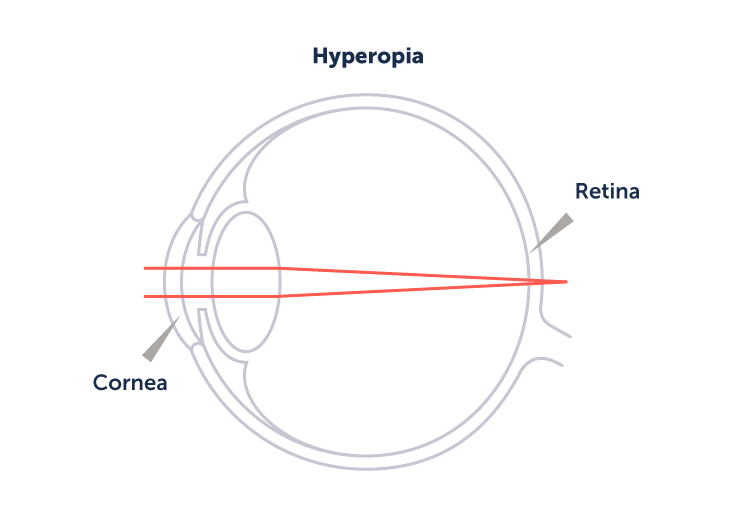
Hyperopia is a defect in the eye’s refraction that occurs when images are focused behind the retina and not directly on it, resulting in blurred or unclear vision at intermediate and close distances. This usually occurs because the cornea or crystalline lens (or both) are weak or the eye is shorter than usual. Thus, people with hyperopia may experience problems reading or watching television, but not in distinguishing road signs when driving. Hyperopia is also often accompanied by astigmatism.

Hyperopia has, in many cases, a hereditary component, so it occurs more often in people with a history of hyperopia in their family. Nevertheless, other factors can also play a role.
Most newborns are hyperopic, a defect that is corrected as the eye develops, until it disappears, in many cases, in their teens. Even so, if during this period the infantile hyperopia is not corrected in an adequate way it can trigger other visual alterations, such as lazy eye or strabismus. In cases where hyperopia is not very high, young people usually compensate for it by accommodating the ocular muscles, but with age this capacity is lost, and the hyperopia that they had during childhood and had disappeared in adolescence reappears, requiring the use of optical correction.
The most common symptoms suffered by people with hyperopia are:
Hyperopia can be corrected by laser refractive surgery (LASIK) or by an intraocular lens implantation. Both options are a quick and effective solution, which also allows for the simultaneous correction not only of hyperopia but also of other refractive defects, such as astigmatism and presbyopia (eyestrain).
In order to choose the most suitable treatment, the particular needs of each patient (work, hobbies, etc.) will be considered and a complete preoperative study will be carried out to assess the characteristics of the eye, including tests such as corneal topography, pupillometry, aberrometry, biometry, etc. The execution of all these tests does not usually take more than a few hours. Considering both things, the best technique for that particular patient will be determined.
People who are not yet considering surgery or who are not yet suitable because their grading is not stable have other options for correcting hyperopia:
In the end, it will be the ophthalmologist who will evaluate each case and recommend the most appropriate option for each patient.
Hyperopia has, in many cases, a hereditary component, so it occurs more often in people with a history of hyperopia in their family. However, other factors can also play a role.
Most children have hyperopia in childhood, but in many cases the accommodation (focusing) capacity of their eye is usually sufficient to compensate for low vision and allow them to see close objects. Still, having to make this accommodation effort can lead to eye strain, discomfort or headaches.
Childhood hyperopia is usually corrected as the eye develops, and decreases, until it disappears, by the teenage years. If by then, hyperopia has not been completely corrected, the defect is likely to persist for the rest of one’s life.
No, hyperopia cannot be prevented, but it is recommended to treat it as soon as possible to avoid its consequences and to control possible related problems.
In theory, any person over 21 years of age with a stable prescription of no more than 5 diopters can have laser surgery. Before that, a complete ophthalmological examination with the necessary refractive tests will be required to confirm its suitability.
People who have hyperopia can also have both astigmatism and, at a later age, presbyopia or eyestrain. However, a person cannot have both hyperopia and myopia at the same time.
Cataract surgery consists of the extraction of the opacified crystalline lens (cataract) and its replacement by an intraocular lens. Thanks to current technology, we can customize this intraocular lens to correct in the same operation the refractive defects of the eye: myopia, hypermetropia, presbyopia (tired sight) and astigmatism.
Yes, in fact, it is common. A person may have had surgery in the past to correct his or her hyperopia and later, due to the natural evolution of the eye, develop a cataract that requires removal. In this case, it is necessary to inform the ophthalmologist so that he or she can consider it when carrying out the tests prior to the intervention of the cataract for the calculation of the intraocular lens.

Contact us or request an appointment with our medical team.